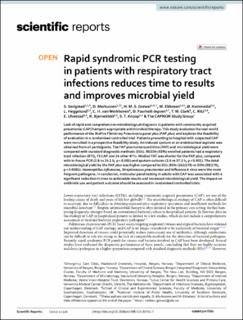| dc.contributor.author | Serigstad, Sondre | |
| dc.contributor.author | Grewal, Harleen | |
| dc.contributor.author | Ebbesen, Marit Helen | |
| dc.contributor.author | Kommedal, Øyvind | |
| dc.contributor.author | Heggelund, Lars | |
| dc.contributor.author | van Werkhoven, Werkhoven | |
| dc.contributor.author | Faurholt-Jepsen, Daniel | |
| dc.contributor.author | Clark, T.W. | |
| dc.contributor.author | Ritz, Christian | |
| dc.contributor.author | Ulvestad, Elling | |
| dc.contributor.author | Bjørneklett, Rune Oskar | |
| dc.contributor.author | Knoop, Siri Tandberg | |
| dc.contributor.author | Ravn, P. | |
| dc.contributor.author | Markussen, Dagfinn Lunde | |
| dc.date.accessioned | 2022-06-01T12:22:16Z | |
| dc.date.available | 2022-06-01T12:22:16Z | |
| dc.date.created | 2022-05-10T15:36:55Z | |
| dc.date.issued | 2022 | |
| dc.identifier.issn | 2045-2322 | |
| dc.identifier.uri | https://hdl.handle.net/11250/2997239 | |
| dc.description.abstract | Lack of rapid and comprehensive microbiological diagnosis in patients with community acquired pneumonia (CAP) hampers appropriate antimicrobial therapy. This study evaluates the real-world performance of the BioFire FilmArray Pneumonia panel plus (FAP plus) and explores the feasibility of evaluation in a randomised controlled trial. Patients presenting to hospital with suspected CAP were recruited in a prospective feasibility study. An induced sputum or an endotracheal aspirate was obtained from all participants. The FAP plus turnaround time (TAT) and microbiological yield were compared with standard diagnostic methods (SDs). 96/104 (92%) enrolled patients had a respiratory tract infection (RTI); 72 CAP and 24 other RTIs. Median TAT was shorter for the FAP plus, compared with in-house PCR (2.6 vs 24.1 h, p < 0.001) and sputum cultures (2.6 vs 57.5 h, p < 0.001). The total microbiological yield by the FAP plus was higher compared to SDs (91% (162/179) vs 55% (99/179), p < 0.0001). Haemophilus influenzae, Streptococcus pneumoniae and influenza A virus were the most frequent pathogens. In conclusion, molecular panel testing in adults with CAP was associated with a significant reduction in time to actionable results and increased microbiological yield. The impact on antibiotic use and patient outcome should be assessed in randomised controlled trials. | en_US |
| dc.language.iso | eng | en_US |
| dc.publisher | Nature Research | en_US |
| dc.rights | Navngivelse 4.0 Internasjonal | * |
| dc.rights.uri | http://creativecommons.org/licenses/by/4.0/deed.no | * |
| dc.title | Rapid syndromic PCR testing in patients with respiratory tract infections reduces time to results and improves microbial yield | en_US |
| dc.type | Journal article | en_US |
| dc.type | Peer reviewed | en_US |
| dc.description.version | publishedVersion | en_US |
| dc.rights.holder | Copyright The Author(s) 2022 | en_US |
| dc.source.articlenumber | 326 | en_US |
| cristin.ispublished | true | |
| cristin.fulltext | original | |
| cristin.qualitycode | 1 | |
| dc.identifier.doi | 10.1038/s41598-021-03741-7 | |
| dc.identifier.cristin | 2023199 | |
| dc.source.journal | Scientific Reports | en_US |
| dc.identifier.citation | Scientific Reports. 2022, 12, 326. | en_US |
| dc.source.volume | 12 | en_US |

